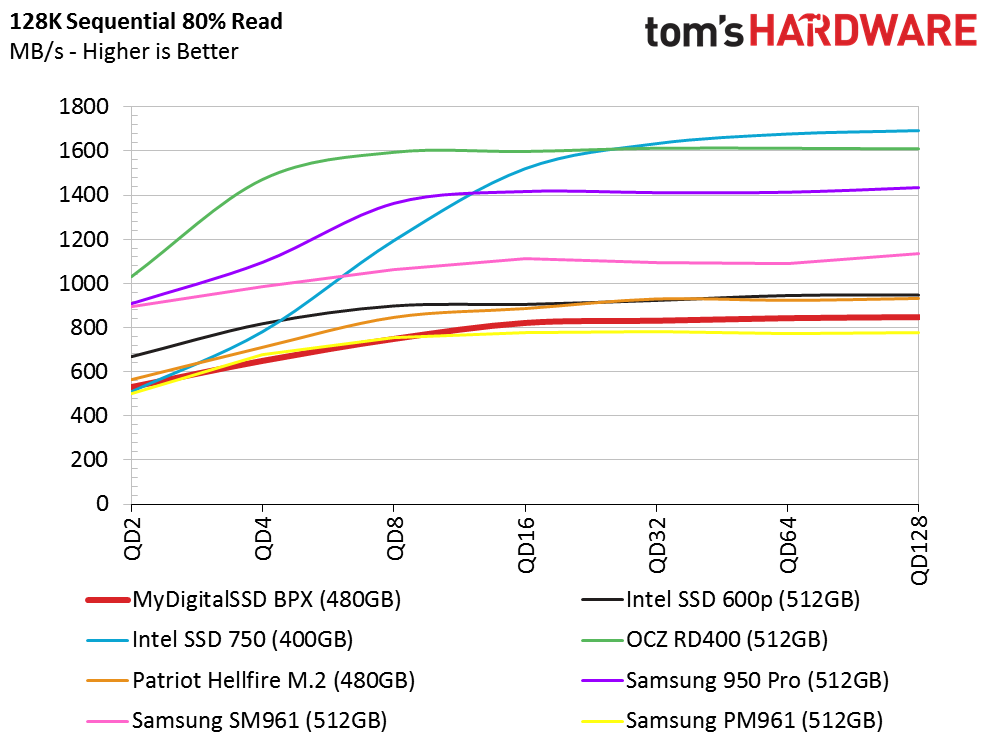MyDigitalSSD BPX Value NVMe SSD Review
Why you can trust Tom's Hardware
Comparisons And Benchmarks - 512GB Class
Comparison Products
We separated the BPX SSDs into two test pools. On this page, we will cover the 512GB class products, and on the next, we will examine the 256GB products. This allows us to compare more products in each group and give you a better view of the current state of the market.
The MyDigitalSSD BPX is one of the lowest priced NVMe products available, and it joins the Intel 600p in the entry-level category based on price. We also include the Samsung PM961 (to represent the upcoming 960 EVO) and Patriot Hellfire M.2. The other products tip the scale with pricing above $300. Those SSDs include the Intel SSD 750 400GB, OCZ RD400, Samsung 950 Pro, and SM961.
The real comparison, though, is between the Intel 600p and MyDigitalSSD BPX. Both products share similar pricing (at the time of writing), and the vendors sell them as true entry-level NVMe products. We expected the Patriot Hellfire M.2 to receive a price drop, but that has not come yet. You will see why Patriot wants to keep its price a little higher in the performance charts.
Sequential Read Performance
To read about our storage tests in-depth, please check out How We Test HDDs And SSDs.We cover four-corner testing on page six of our How We Test guide.
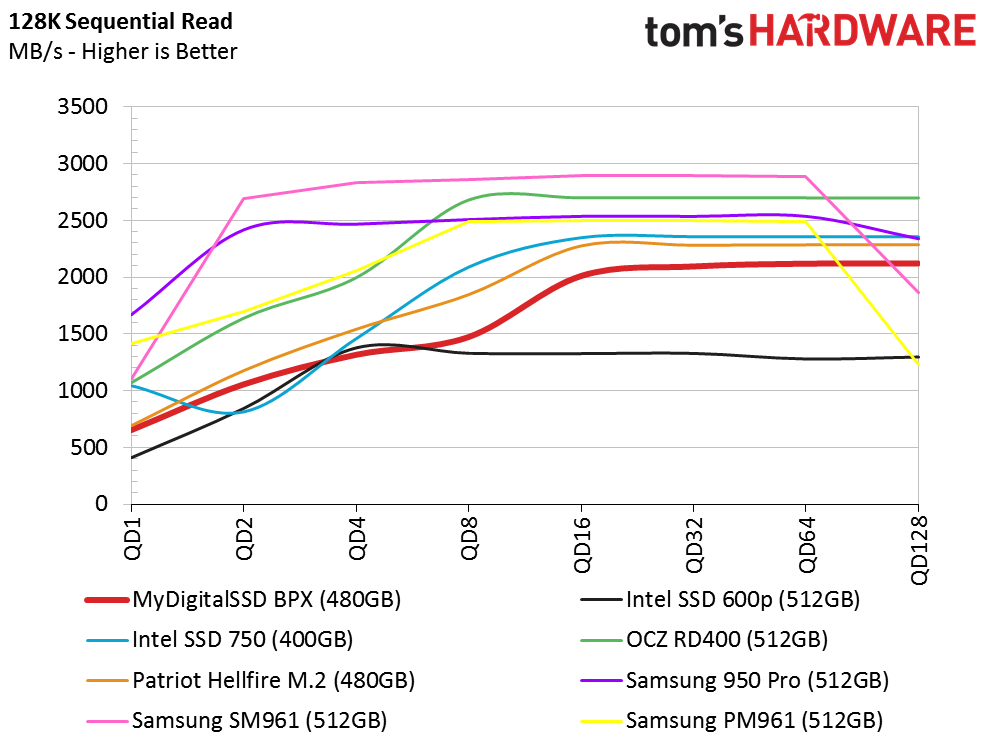

Many of the NVMe SSDs are faster than the MyDigitalSSD BPX 480GB, but only one product matches its low price point. The BPX is faster than the Intel 600p in many of the tests we'll present in this review. The gap between the two drives will vary depending on the workload type. In sequential reads, the BPX 480GB is a little over 200 MB/s faster than the 600p at queue depth 2.
Sequential Write Performance


The BPX stretches the performance lead in workloads where the 600p's TLC buffer becomes a disadvantage. The 480GB model writes sequential data at nearly double the rate of the 600p. The BPX offers faster application installations and file transfers for data coming to the drive from another high-speed source.
Random Read Performance

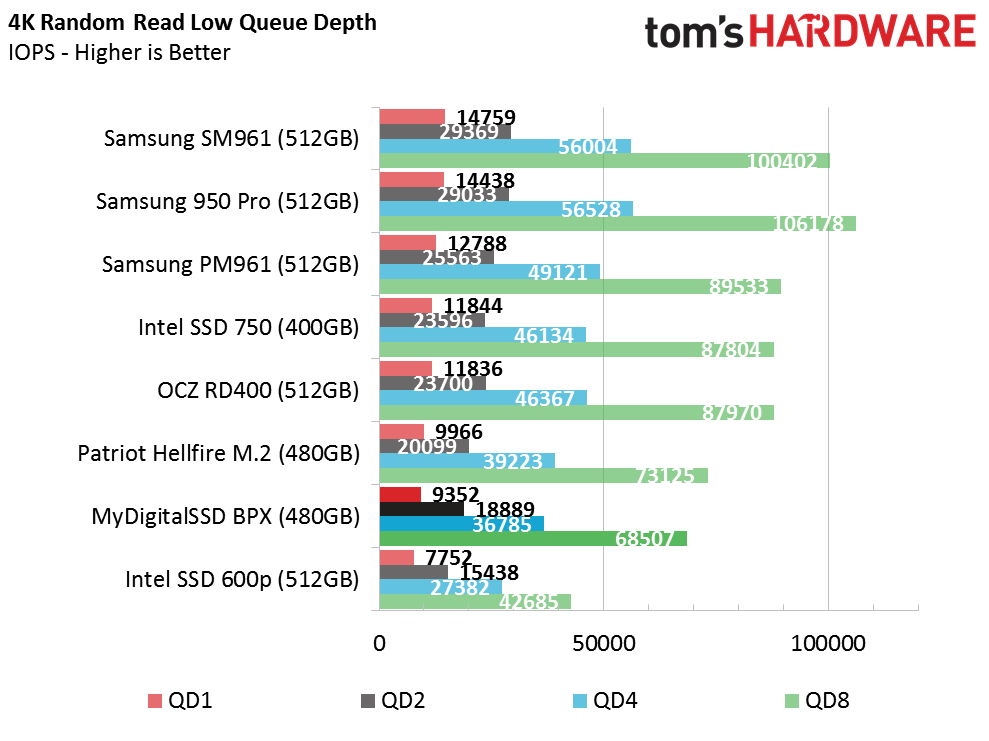

The BPX 480GB also offers a large performance increase during small-block random read workloads. Most consumer workloads hover around queue depth 1 and 2 with short interspersed data bursts in the queue depth 4 range. Difficult workloads will widen the performance gap between the two products during random read workloads.
Get Tom's Hardware's best news and in-depth reviews, straight to your inbox.
Random Write Performance



One interesting aspect we noticed is that the MyDigitalSSD BPX does not follow the same performance trends as the Patriot Hellfire M.2. The Hellfire M.2 is faster in many of the tests, but the margin is small in all of our four-corner tests.
The performance difference between the Intel 600p and the MyDigitalSSD BPX is much larger.
80 Percent Mixed Sequential Workload
We describe our mixed workload testing in detail here and describe our steady state tests here.
The Intel 600p outperforms the BPX in this single test in our suite. The 600p performs a little better during the sequential mixed workload test. The results surprised us because the 20% data writes should have been faster on the BPX because they come from the MLC flash. We suspect this is a controller firmware issue that Phison could fix with additional tuning.
80 Percent Mixed Random Workload
The mixed random test finds the MyDigitalSSD BPX back above the Intel 600p, but only at mid-level queue depths, and not by a large margin. This may keep the drives closer together in the real-world application workloads we examine later in this review.
Sequential Steady-State



None of the products in the test pool were designed or tuned for enterprise-level steady-state workloads (except the Intel SSD 750 that shares some DNA with Intel's data center products). Samsung tuned the SM961 and 950 Pro for professional applications that can force a drive into light steady-state conditions during heavy use with applications such as Sony Vegas and Adobe Premier.
Video production applications make use of NVMe's lower latency and higher throughput capabilities. Many of the MLC-based products on the chart outperform the best SATA SSDs in this type of environment. The TLC-based products even give the best SATA products a solid run.
Random Steady-State


Intel made a big deal about performance consistency and high random write performance when it first launched its leading-edge NVMe products, but that emphasis has trailed off in recent years. The 600p trails the other products on the chart, and that opens the door for other low-cost products to enter the consumer RAID array portion of the market. The MyDigitalSSD delivers more consistent and higher random write performance under steady-state conditions. The drive would work better in a RAID array hanging off an Intel motherboard PCH.
PCMark 8 Real-World Software Performance
For details on our real-world software performance testing, please click here.
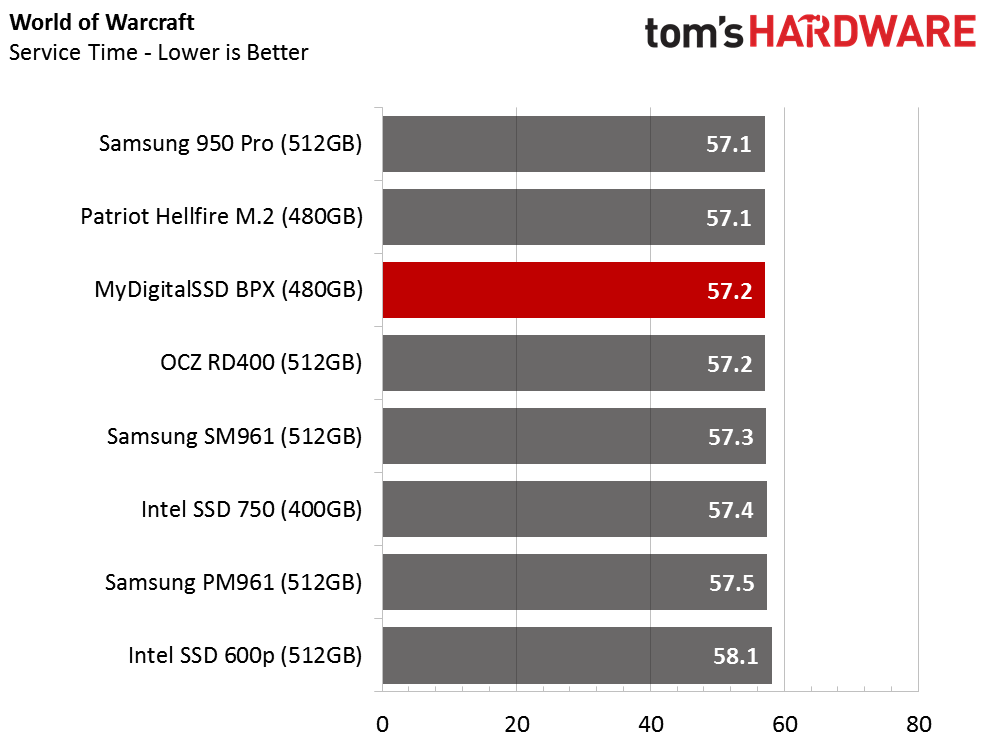


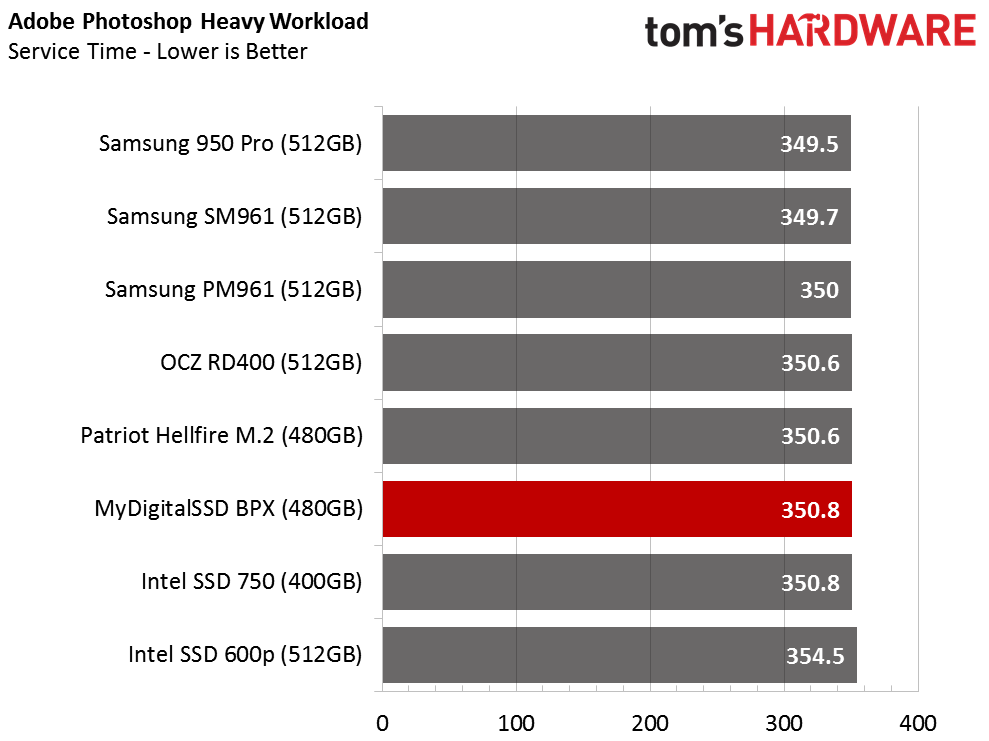






Phison, the controller maker for the MyDigitalSSD BPX and Patriot Hellfire M.2, recently released a new firmware to manufacturers that increased real-world application performance. Both drives now perform much better than what the synthetic tests would lead us to believe.
The BPX outperforms the 600p in every application test, but that shouldn't surprise you by now.
Application Storage Bandwidth
In this view, we average of all the PCMark 8 tests into a single throughput metric to give a general view of performance. We were surprised to see the BPX outperform the Samsung PM961 in many of the tests. The MyDigitalSSD BPX also outperformed the Intel SSD 750 400GB in the averaged results.
PCMark 8 Advanced Workload Performance
To learn how we test advanced workload performance, please click here.
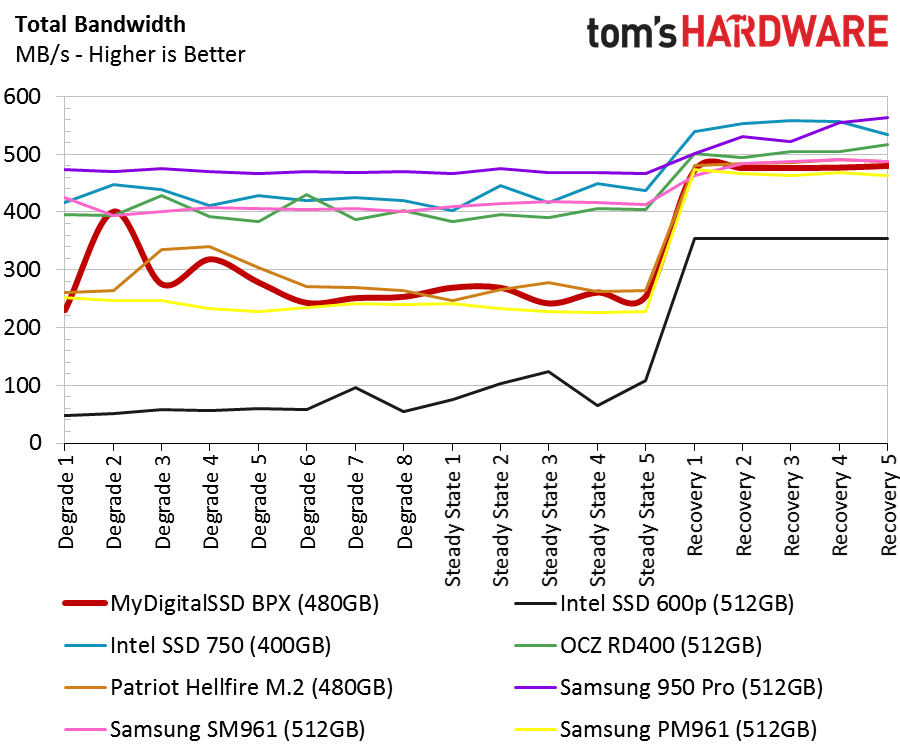


Under heavier conditions, the MyDigitalSSD BPX delivers similar performance to the Samsung PM961 512GB SSD. The BPX, PM961, and the Patriot Hellfire M.2 are very close in all results with both heavy and moderate stress on the drives.
Total Service Time



The Intel 600p suffers from high latency during heavy workloads, along with every product we've tested with IMFT 3D NAND. The service time tests reveal the high latency, but it also highlights that the MyDigitalSSD BPX is very close to the premium Samsung SM961 and OCZ RD400.
Disk Busy Time
The disk busy time test reveals the clearest distinction between the Intel 600p and BPX. The Intel has to spend more time working to satisfy the same workload. The other tests show that as well, but this test shows the amount of time the SSD spends on the workload, rather than just the finished result.
Notebook Battery Life


Phison's 2.1 firmware didn't fix the high power consumption when the SSD is under notebook battery power. Part of the issue stems from the lack of an optimized NVMe driver. The Intel 600p does not have an optimized NVMe driver, either. Intel told us a software package would be available in mid-November, but Phison hasn't given us a date or any indication that a custom driver will ever be available.
Current page: Comparisons And Benchmarks - 512GB Class
Prev Page Specifications And Features Next Page Performance Data - 256GB Class
Chris Ramseyer was a senior contributing editor for Tom's Hardware. He tested and reviewed consumer storage.
-
JakeWearingKhakis Look at the 2nd to last picture of the Phison chip. Whatever they did to make it look that cool, needs to be a standard thing!Reply -
Game256 This is actually not a bad budget NVMe SSD. This SSD is more like what Intel 600p should look like. Because Intel 600p is a disgrace for a NVMe drive.Reply
However Samsung 960 EVO will cost about the same, especially 250 Gb version. -
InvalidError Reply
What is so special about that picture? The "wavy" pattern? Nothing special about that, it is just an uneven wafer cut, possibly caused by a worn diamond saw blade, insufficient lubrication/flushing, uneven pressure through the cut or any number of other flaws in the wafer cutting process.18792461 said:Look at the 2nd to last picture of the Phison chip. Whatever they did to make it look that cool, needs to be a standard thing! -
shrapnel_indie It's just frustrating when you find a review someplace and all it turns out to be is pretty much the marketing description verbatim (or nearly so) and no hands-on testing, lab or otherwise. (You see this quite a bit with products unfortunately.)Reply
It's one reason sites like this can be, and are, valuable tools. Keep up the good work. -
Jordan_72 Thank you for the article, it will be very helpful for me when considering my next storage solution.Reply -
Xajel I wonder how these will compare against Samsung 960 Evo, for the 512GB part, Samsung is $50 pricier than this with a little higher performance than this on paper, but with less enduranceReply -
CRamseyer It will be interesting to see for sure. We tested the PM961 (results are in the 512GB charts) and its a close battle. It really depends on your workload but as they say, $50 is $50.Reply -
Bruce427 Thanks for the great review, Chris.Reply
I was all set to order the 240GB version as a place holder until the Samsung 960 drives are delivered (looks like Samsung is going to significantly miss their "October" target -- especially on the EVOs).
But the exceptionally low notebook battery life spoiled the deal for me.
You said Phison has been unable to replicate your low notebook battery life results with the E7 controller. Is it possible that the drive might exhibit better battery life performance in a notebook other than a Lenovo? -
nebun where is the heatsink....these things get really hot under load....they really need to do something about it....not throttle it down...that's a patch, not a fixReply -
Brian_R170 The listed price doesn't quite match the Intel 600p street price, but maybe when it hits retailers, it'll be closer.Reply
Not many reviews of MyDigitalSSD products or service compared to better-known brands, though.



